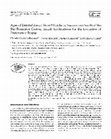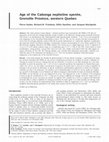Papers by Gilles Gauthier

Gondwana Res, 2004
In this work we report 207Pb/Z06Pb LA-ICPMS ages of 152 detrital zircons from lower greenschist f... more In this work we report 207Pb/Z06Pb LA-ICPMS ages of 152 detrital zircons from lower greenschist facies quartzites from Proterozoic basin successions of the southern border of the ,550 Francisco Craton, southern Minas Gerais State, Brazil. These are the intracratonic SCo Jo50 del Rei basin, the intraplate continental margin Andreldndia basin, and the Serra do Our0 Grosso sequence, developed on a crystalline basement older than 1.8 Ga, and deformed and metamorphosed during the Brasiliano Orogeny, ca. 0.59-0.50 Ga. The data constrain both the ages of the sources and the interval of sedimentation. The detrital zircons of the Serra do Ouro Grosso sequcnce were derived predominantly from the erosion of a Neoarchean crust, 2.5-2.8 Ga old, with only one grain showing a Paleoproterozoic age (2,245283 Ma) older than the Transamazonian event. Zircons extracted from a shelf quartzite of thc lowermost sequence of the SCo JoCo del Rei basin indicate derivation from the 1.8-2.2 Ga Transamazonian crust, with subordinate contribution from the 2.5-2.9 Ga Archean crust. The 1,809+41 Ma age is interpreted as the maximum limit for sedimentation in this basin. The results confirm the regional correlation with the Espinhaqo Rift successions. The zircons extracted from an autochthonous quartzite of the Andreldndia sequence yielded ages in the 1.0-2.2 Ga range, with a modal class at 1.2-1.3 Ga. Only two of the forty analyzed zircons yield Archean ages. The youngest zircon yields 1,086285 Ma. The zircons from the alloehthonous quartzite yield ages between 1.0-2.7 Ga, with a modal class at 2.1-2.2 Ga. Only five of 45 analyzed grains yield Archean ages. The youngest zircon has an age of 1,047-1-77 Ma. The results indicate that the detrital sediments deposited during the second marine flooding event of the Andrelindia sedimentation were mainly derived from the erosion of Mesoproterozoic and Paleoproterozic rocks. The 1,047277 Ma age is interpreted as the maximum depositional age for the described association. K e y words: Detrital zircon 207Pb/206Pb ages, laser ablation ICPMS, Proterozoic basins, southern S5o Francisco Craton, Brazil. 914 C.S. VALLADARES ET AL.
Arctic, Nov 22, 2013
ABSTRACT

Gondwana Research, 2004
In this work we report 207Pb/Z06Pb LA-ICPMS ages of 152 detrital zircons from lower greenschist f... more In this work we report 207Pb/Z06Pb LA-ICPMS ages of 152 detrital zircons from lower greenschist facies quartzites from Proterozoic basin successions of the southern border of the ,550 Francisco Craton, southern Minas Gerais State, Brazil. These are the intracratonic SCo Jo50 del Rei basin, the intraplate continental margin Andreldndia basin, and the Serra do Our0 Grosso sequence, developed on a crystalline basement older than 1.8 Ga, and deformed and metamorphosed during the Brasiliano Orogeny, ca. 0.59-0.50 Ga. The data constrain both the ages of the sources and the interval of sedimentation. The detrital zircons of the Serra do Ouro Grosso sequcnce were derived predominantly from the erosion of a Neoarchean crust, 2.5-2.8 Ga old, with only one grain showing a Paleoproterozoic age (2,245283 Ma) older than the Transamazonian event. Zircons extracted from a shelf quartzite of thc lowermost sequence of the SCo JoCo del Rei basin indicate derivation from the 1.8-2.2 Ga Transamazonian crust, with subordinate contribution from the 2.5-2.9 Ga Archean crust. The 1,809+41 Ma age is interpreted as the maximum limit for sedimentation in this basin. The results confirm the regional correlation with the Espinhaqo Rift successions. The zircons extracted from an autochthonous quartzite of the Andreldndia sequence yielded ages in the 1.0-2.2 Ga range, with a modal class at 1.2-1.3 Ga. Only two of the forty analyzed zircons yield Archean ages. The youngest zircon yields 1,086285 Ma. The zircons from the alloehthonous quartzite yield ages between 1.0-2.7 Ga, with a modal class at 2.1-2.2 Ga. Only five of 45 analyzed grains yield Archean ages. The youngest zircon has an age of 1,047-1-77 Ma. The results indicate that the detrital sediments deposited during the second marine flooding event of the Andrelindia sedimentation were mainly derived from the erosion of Mesoproterozoic and Paleoproterozic rocks. The 1,047277 Ma age is interpreted as the maximum depositional age for the described association. K e y words: Detrital zircon 207Pb/206Pb ages, laser ablation ICPMS, Proterozoic basins, southern S5o Francisco Craton, Brazil. 914 C.S. VALLADARES ET AL.
Chemical Geology, 1996
Ages of detrital zircon grains from four samples of Paleoproterozoic metasedimentary rocks from n... more Ages of detrital zircon grains from four samples of Paleoproterozoic metasedimentary rocks from northeastern Laurentia, Canada, analysed by thermal ionisation mass spectrometry (TIMS) and laser-ablation microprobe inductively-coupled plasma quadrnpole mass spectrometry (LAM-ICP-MS), are presented and the methods compared. The TIMS results are more precise (+0.1% of age) and in the case of concordant analyses more accurate than the LAM-ICP-MS analyses (+ 1-2% precision), but both methods show a similar distribution of ages from each sample. Used as complimentary techniques, the combination of TIMS and LAM-ICP-MS analyses yield rapid, precise, and accurate information on the provenance of siliciclastic rocks, offering a powerful tool for the interpretation of the tectonic significance of sedimentary sequences in orogenic belts.

Canadian Journal of Earth Sciences, 2006
This study presents isotope dilution -thermal ionization mass spectrometry (ID-TIMS) U-Pb data fo... more This study presents isotope dilution -thermal ionization mass spectrometry (ID-TIMS) U-Pb data for megacrystic zircon from the Cabonga Nepheline Syenite Complex of the Réservoir Cabonga terrane (Grenville Province). This terrane is an allochthonous slab metamorphosed under granulite-grade conditions -1.18-1.14 Ga and transported onto migmatites of the Grenvillian Parautochthon at about 1.02 Ga. The very low uranium and lead concentrations of zircon from the Cabonga nepheline syenite (CNS) did not permit determination of a statistically significant crystallization age using laser ablation microbeam techniques. Consequently, extensive microsampling (15 zircon chips), guided by X-ray and electronic imaging, followed by ID-TIMS analyses were carried out on a single megacrystic zircon. A regression of 13 out of 15 U-Pb isotopic analyses results in a crystallization age of 1171 ± 3 Ma for the CNS. Criteria based on zircon morphologies, zoning patterns, varying Th/U ratios (0.3-0.9), and a highly fractionated Zr/Hf ratio suggest an igneous derivation for the CNS. The Cabonga alkaline rocks, intruded under high-grade metamorphic conditions, preceded the onset of the widespread and ubiquitous (1.15 ± 0.01 Ga) anorthosite-mangerite-charnockite-granite magmatism in the southern part of the Grenville Province.

Geochimica et Cosmochimica Acta, 1996
The recently developed method of laser ablation-inductively coupled plasma mass spectrometry (LA-... more The recently developed method of laser ablation-inductively coupled plasma mass spectrometry (LA-ICPMS) allows the determination of *"Pb/*"Pb ages of single zircon grains. The main advantages of the method are minimal sample preparation, low cost, and high throughput. In this work we present an analytical routine for geochronological analyses of zircon and monazite by LA-ICPMS and its application to the Ribeira Belt of the Brazilian Orogen in southeastern Brazil. The 207Pb/206Pb ages of one hundred and thirty-seven detrital zircons from amphibolite facies quartzites from three lithotectonic domains in the central Ribeira Belt indicate that they are derived mainly from Paleoproterozoic crust of Transamazonian age (2.0-2.3 Ga). A small number of zircons originated in 2.6-2.9 Ga Archean crust. These results are coherent with 2.1-2.2 Ga and 2.6-3.0 Ga U-Pb ages previously obtained for basement gneisses. The viability of the method to date monazite is also assessed. Monazites from the same quartzite samples yield ages between 2.1 Ga and 0.57 Ga indicating variable resetting of the U-Pb system during amphibolite facies metamorphism. In contrast, monazite from a basement migmatite and syn-metamorphic granitoids yields ages in the 500-700 Ma range, in general agreement with U-Pb ages of 590-565 Ma for the main metamorphic event.

The purpose of this paper is to emphasize the benefits of adopting non-destructive energy dispers... more The purpose of this paper is to emphasize the benefits of adopting non-destructive energy dispersive X-ray fluorescence (ED-XRF) as a first-order technique to determine chert whole-rock geochemistry for archaeological sourcing. Chemical signatures for the Touladi and La Martre prehistoric quarries from the lower St. Lawrence and Gaspé Peninsula region of Quebec, Canada, are determined and serve as references to test the provenance of regional chert artifacts. Chert experimental flakes, created from quarry geological hand samples, are analyzed and used to validate the method. Archaeological flakes and tools recovered from three archaeological sites are analyzed and tested against quarry samples. Geochemical diagrams and Principal Component Analysis are used to establish artifact-quarry relationships. The effects of surface weathering on the geochemical analysis of archaeological chert artifacts are presented. Sample restoration and research avenues are discussed and proposed to further enhance the robustness of future chert geochemical data sets.

Journal canadien d'archéologie, 2012
FRANÇAIS: La cornéenne est un matériau lithique fréquemment retrouvé sur les sites archéologiques... more FRANÇAIS: La cornéenne est un matériau lithique fréquemment retrouvé sur les sites archéologiques préhistoriques du Québec méridional. On l’associe généralement aux occupations de l’Archaïque post-laurentien (4500–3000 A.A.), mais cette étude montre que l’utilisation de ce matériau n’est pas exclusive à cette période. Les analyses physico-chimiques présentées ici permettent d’identifier une source potentielle et vraisemblablement principale de ce matériau, la cornéenne du mont Royal. La pétrologie de ce type de roche indique un métamorphisme essentiellement thermique opérant dans l’environnement immédiat de massifs intrusifs. Il faut donc considérer la cornéenne présente sur les autres collines montérégiennes en tant que sources potentielles, même si celles-ci sont à ce jour non documentées par l’archéologie.
ENGLISH: Hornfels is a lithic material frequently discovered on prehistoric sites in southern Quebec. It is commonly associated with Terminal Archaic (or “post-laurentian” Archaic [4500–3000 B.P.]) occupations, but this study demonstrates that such an association can be misleading. The results of the physical and chemical analyses presented here also indicate that Mont Royal, a small hill located in the city of Montreal, is the most probable source of hornfels used in prehistoric times. Outcrops of hornfels exist on some other Monteregian Hills, but to this day there are no archaeological indications that they were exploited by aboriginal groups.

Earth and Planetary Science Letters, 1996
The São Francisco shield is one of the major cratonic units forming the backbone of the South Ame... more The São Francisco shield is one of the major cratonic units forming the backbone of the South American continent. The Quadrilátero Ferrífero area, in the south of the shield, is underlain by three major units: granitic-gneissic terrains with a minimum age of 2860 Ma; the Rio das Velhas greenstone belt, emplaced at 2772–2780 Ma; and the Minas Supergroup-Itacolomi Group Paleoproterozoic sedimentary sequences. The 207Pb206Pb and UPb ages of more than 400 detrital zircons obtained by Laser ablation-ICPMS and isotope dilution lead to the following conclusions: (1) the Rio das Velhas greenstone belt contains exclusively cratogenic sediments and developed on, or proximal to, old, evolved continental crust with a minimum age of ca. 2.85 Ga; (2) the lower detrital sequence of the Minas Supergroup was supplied with sediments derived from both the granite-greenstone terrain and the surrounding older crust; (3) the upper unit of the Minas Supergroup (Sabará Formation) contains 2125 Ma zircon and the overlying Itacolomi Group contain zircons with minimum ages of ca. 2.06 Ga, identical to the ages of regional metamorphism. Together with other considerations, these ages lead to the novel proposal that the tectogenic sedimentation represented by these units occurred in a foreland basin of the Transamazonian orogen. Basin evolution was closely associated with the tectonic development of the orogen and uplift of basement complexes between 2125 Ma and 2030 Ma.The scarcity of 2.6-2.4 Ga zircons in the Proterozoic units of the Quadrilátero Ferrífero confirms previous results for the São Francisco shield and is symptomatic of the absence of magmatic-metamorphic activity in that period of time.

Geochimica Et Cosmochimica Acta, 1996
The recently developed method of laser ablation-inductively coupled plasma mass spectrometry (LA-... more The recently developed method of laser ablation-inductively coupled plasma mass spectrometry (LA-ICPMS) allows the determination of *"Pb/*"Pb ages of single zircon grains. The main advantages of the method are minimal sample preparation, low cost, and high throughput. In this work we present an analytical routine for geochronological analyses of zircon and monazite by LA-ICPMS and its application to the Ribeira Belt of the Brazilian Orogen in southeastern Brazil. The 207Pb/206Pb ages of one hundred and thirty-seven detrital zircons from amphibolite facies quartzites from three lithotectonic domains in the central Ribeira Belt indicate that they are derived mainly from Paleoproterozoic crust of Transamazonian age (2.0-2.3 Ga). A small number of zircons originated in 2.6-2.9 Ga Archean crust. These results are coherent with 2.1-2.2 Ga and 2.6-3.0 Ga U-Pb ages previously obtained for basement gneisses. The viability of the method to date monazite is also assessed. Monazites from the same quartzite samples yield ages between 2.1 Ga and 0.57 Ga indicating variable resetting of the U-Pb system during amphibolite facies metamorphism. In contrast, monazite from a basement migmatite and syn-metamorphic granitoids yields ages in the 500-700 Ma range, in general agreement with U-Pb ages of 590-565 Ma for the main metamorphic event.





Uploads
Papers by Gilles Gauthier
ENGLISH: Hornfels is a lithic material frequently discovered on prehistoric sites in southern Quebec. It is commonly associated with Terminal Archaic (or “post-laurentian” Archaic [4500–3000 B.P.]) occupations, but this study demonstrates that such an association can be misleading. The results of the physical and chemical analyses presented here also indicate that Mont Royal, a small hill located in the city of Montreal, is the most probable source of hornfels used in prehistoric times. Outcrops of hornfels exist on some other Monteregian Hills, but to this day there are no archaeological indications that they were exploited by aboriginal groups.
ENGLISH: Hornfels is a lithic material frequently discovered on prehistoric sites in southern Quebec. It is commonly associated with Terminal Archaic (or “post-laurentian” Archaic [4500–3000 B.P.]) occupations, but this study demonstrates that such an association can be misleading. The results of the physical and chemical analyses presented here also indicate that Mont Royal, a small hill located in the city of Montreal, is the most probable source of hornfels used in prehistoric times. Outcrops of hornfels exist on some other Monteregian Hills, but to this day there are no archaeological indications that they were exploited by aboriginal groups.